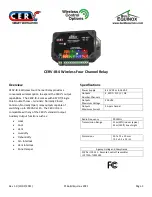
EMR-4000
IM02602009E
Behavior of the Fault Recorder
Who triggers the Fault Recorder?
The
Fault Recorder will be triggered by the rising edge of the »P
ROT
.P
ICKUP
« (General Pickup) signal.
Please note that
»
P
ROT
.P
ICKUP
«
(General Pickup) is an or-connection of all Pickup signals. The first Pickup will trigger the Fault recorder.
At which point of time will the fault measurements be captured?
The fault measurements will be captured (written) when the trip decision is taken. The point in time, when the
measurements are captured (after a trip) can be delayed optionally by the parameter »
t-meas-delay«. This might be
reasonable in order to achieve more reliable measuring values (e.g. in order to avoid measuring disturbances caused
by significant DC-components).
Modes
In case of a fault record should be written even if an general alarm has not lead to a trip, the parameter »
Record-Mode«
is to be set to »
Alarms and Pickups« .
Set parameter »
Record-Mode« to »Trips only«, if an Alarm that is not followed by a trip decision should not lead to a
trip.
When does the overlay (popup) appears on the display of the HMI?
A popup will appear on the HMI display, when the General Pickup (Prot.Pickup) disappears.
No time to trip will be shown if the pickup signal that triggers the fault
recorder is issued by another protection module than the trip signal. This
might happen if more than one protection module is involved into a fault.
Please note: The parameter settings (thresholds etc.) that are shown in a fault
record are not part of the fault record itself. They are always read out from the
current device setting. If parameters settings that are shown in a fault record could
have been updated, they will be indicated with an asterisk symbol within the fault
record.
To prevent this please proceed as follows:
Save any fault record that should be archived to your local network/hard disk
before doing any parameter change. Delete all the fault records in your fault
recorder afterwards.
Memory
The last stored fault record is saved (fail-safe) within the
Fault Recorder (the others are saved within a memory that
depends on the auxiliary power of the protective relay). If there is no more memory free, the oldest record will be
overwritten (FIFO). Up to 20 records can be stored.
www.eaton.com
195
















































